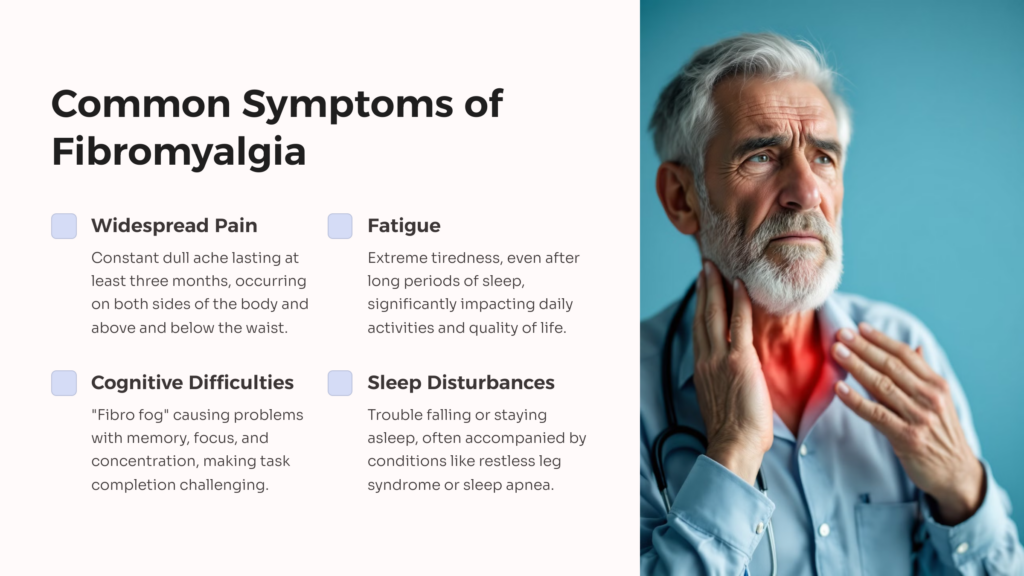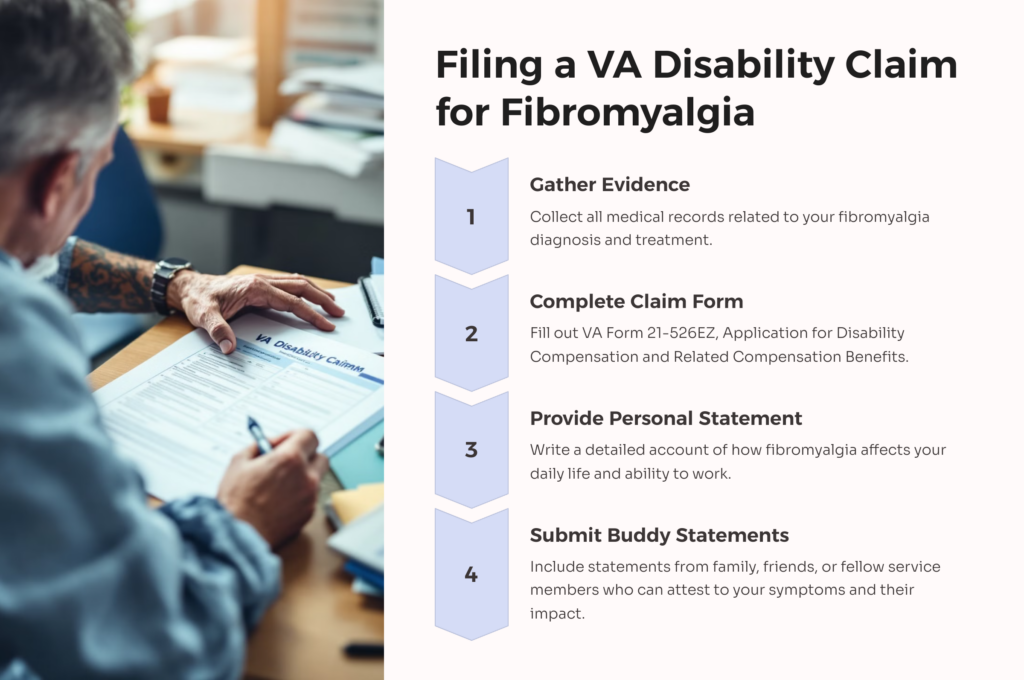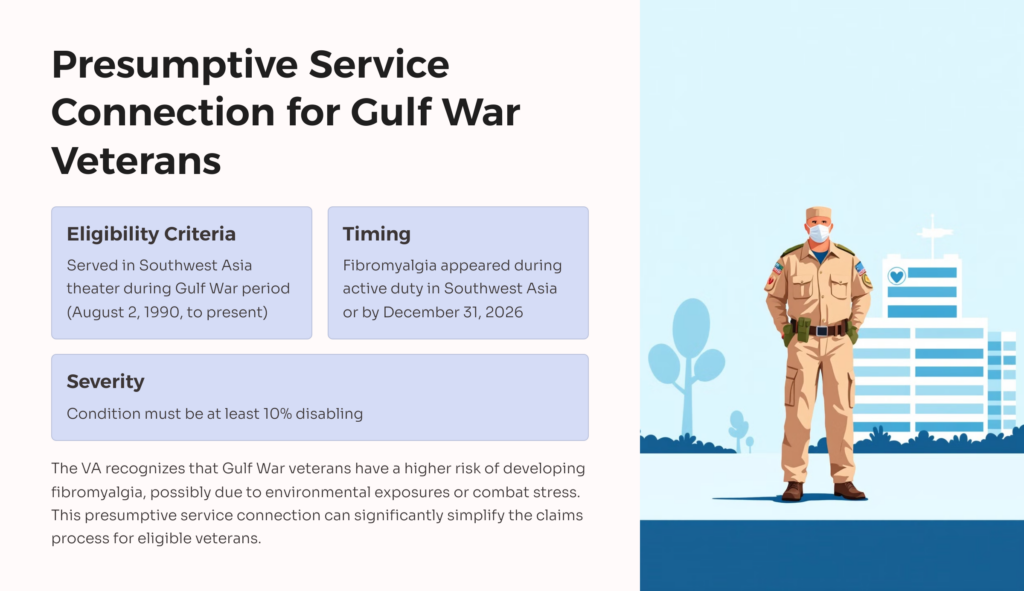Fibromyalgia is a chronic condition that affects millions of people, including many veterans. It causes widespread pain throughout the body, often accompanied by fatigue, sleep problems, memory issues, and mood changes. While the exact cause of fibromyalgia is unknown, it’s believed to be related to how the brain processes pain signals.
For veterans, fibromyalgia can be especially challenging. The physical and emotional stress of military service may contribute to its development or worsen existing symptoms. Many veterans find that fibromyalgia impacts their daily lives, making it difficult to work, maintain relationships, and enjoy activities they once loved.
The good news is that the Department of Veterans Affairs (VA) recognizes fibromyalgia as a disabling condition. This means veterans who develop fibromyalgia due to their military service may be eligible for disability compensation and other VA benefits. Understanding how the VA rates fibromyalgia is crucial for veterans seeking the support they deserve.
Symptoms of Fibromyalgia

Fibromyalgia can manifest in various ways, and symptoms may vary from person to person. However, there are some common signs that veterans should be aware of:
1. Widespread pain: This is the hallmark symptom of fibromyalgia. The pain is often described as a constant dull ache that lasts for at least three months. To be considered widespread, the pain must occur on both sides of the body and above and below the waist.
2. Fatigue: Many people with fibromyalgia experience extreme tiredness, even after sleeping for long periods. This fatigue can significantly impact daily activities and quality of life.
3. Cognitive difficulties: Often referred to as “fibro fog,” this symptom includes problems with memory, focus, and concentration. Veterans may find it challenging to complete tasks or remember important information.
4. Sleep disturbances: Despite feeling exhausted, people with fibromyalgia often have trouble falling asleep or staying asleep. They may also experience conditions like restless leg syndrome or sleep apnea.
Other common symptoms include headaches, digestive problems, and sensitivity to temperature, light, or sound. Some veterans may also experience depression or anxiety as a result of dealing with chronic pain and other fibromyalgia symptoms.
It’s important for veterans experiencing these symptoms to seek medical attention. A proper diagnosis is crucial for receiving appropriate treatment and potentially qualifying for VA disability benefits.
How the VA Rates Fibromyalgia
The VA uses a specific rating system to determine the level of disability caused by fibromyalgia. This system helps ensure that veterans receive fair compensation based on how severely the condition affects their daily lives and ability to work.
For fibromyalgia, the VA assigns ratings of 10%, 20%, or 40%. These percentages correspond to the severity of symptoms and their impact on the veteran’s life. The higher the rating, the more compensation a veteran may receive.
It’s important to note that fibromyalgia is rated under a single diagnostic code (5025) in the VA’s Schedule for Rating Disabilities. This means that even if a veteran experiences multiple symptoms related to fibromyalgia, they will receive one overall rating for the condition.
The VA considers factors such as the frequency and severity of symptoms, how well the condition responds to treatment, and how much it interferes with daily activities when determining a rating. Veterans should provide detailed information about their symptoms and how fibromyalgia affects their lives when filing a claim.
VA Rating Criteria for Fibromyalgia
Understanding the specific criteria the VA uses to rate fibromyalgia can help veterans better prepare their claims. Here’s a breakdown of the rating levels:
- 10% rating: Symptoms require continuous medication for control.
- 20% rating: Symptoms are episodic, with exacerbations often precipitated by environmental or emotional stress or by overexertion, but are present more than one-third of the time.
- 40% rating: Symptoms are constant, or nearly so, and refractory to therapy.
To qualify for the 40% rating, which is the highest available for fibromyalgia, veterans must show that their symptoms are nearly constant and don’t respond well to treatment. This could mean experiencing widespread pain, fatigue, sleep disturbances, and other symptoms most days, with little relief from medications or other therapies.
It’s crucial for veterans to work closely with their healthcare providers to document the frequency, severity, and impact of their symptoms. Detailed medical records and personal statements can strengthen a claim for a higher rating.
Filing a VA Disability Claim for Fibromyalgia

Filing a VA disability claim for fibromyalgia requires careful preparation and documentation. Here are the steps veterans should follow:
1. Gather evidence: Collect all medical records related to your fibromyalgia diagnosis and treatment. This includes records from both VA and private healthcare providers.
2. Complete the claim form: Fill out VA Form 21-526EZ, Application for Disability Compensation and Related Compensation Benefits. You can file your claim online, by mail, or in person at a VA regional office.
3. Provide a personal statement: Write a detailed account of how fibromyalgia affects your daily life and ability to work. Include specific examples of limitations you experience.
4. Submit buddy statements: If possible, include statements from family members, friends, or fellow service members who can attest to your symptoms and how they’ve impacted you.
The VA may schedule you for a Compensation and Pension examination to assess the severity of your condition. Be honest and thorough in describing your symptoms during this exam.
Remember, the key to a successful claim is providing comprehensive evidence that clearly shows how fibromyalgia is connected to your military service and how it affects your life. Don’t hesitate to seek help from a Veterans Service Organization or a VA-accredited attorney if you need assistance with your claim.
Presumptive Service Connection for Gulf War Veterans

For veterans who served in the Southwest Asia theater of operations during the Gulf War, fibromyalgia is considered a presumptive condition. This means that if you’re diagnosed with fibromyalgia and meet certain criteria, the VA will presume that your condition is related to your military service.
To qualify for presumptive service connection, you must meet the following requirements:
1. You must have served in the Southwest Asia theater of operations during the Gulf War period (August 2, 1990, to the present).
2. Your fibromyalgia must have appeared during active duty in the Southwest Asia theater of operations or by December 31, 2026.
3. The condition must be at least 10% disabling.
The VA recognizes that Gulf War veterans have a higher risk of developing fibromyalgia, possibly due to environmental exposures or the stress of combat. If you’re a Gulf War veteran with fibromyalgia, this presumptive service connection can significantly simplify the claims process.
Even if you don’t qualify for presumptive service connection, you can still file a claim for fibromyalgia. You’ll need to provide evidence showing that your condition is directly related to your military service.
Secondary Service Connection for Fibromyalgia
In some cases, fibromyalgia may develop as a result of another service-connected condition. This is known as secondary service connection. For example, if a veteran has a service-connected back injury that leads to chronic pain, which then results in fibromyalgia, they may be eligible for secondary service connection.
To establish a secondary service connection for fibromyalgia, you’ll need to provide:
1. Medical evidence of your current fibromyalgia diagnosis
2. Proof of an existing service-connected condition
3. Medical evidence linking your fibromyalgia to the service-connected condition
It’s important to have a medical professional provide a clear, well-reasoned opinion explaining how your service-connected condition led to the development of fibromyalgia. This can greatly strengthen your claim for secondary service connection.
Common Secondary Conditions to Fibromyalgia
While fibromyalgia itself can be service-connected, it can also lead to other conditions that may qualify for additional VA disability ratings. Some common secondary conditions to fibromyalgia include:
1. Depression and anxiety: Chronic pain and fatigue can often lead to mental health issues. If you develop depression or anxiety as a result of your fibromyalgia, you may be eligible for an additional rating.
2. Sleep disorders: Many veterans with fibromyalgia struggle with sleep issues. Conditions like insomnia or sleep apnea that develop due to fibromyalgia could be rated separately.
3. Migraines: Frequent headaches are a common symptom of fibromyalgia, and if severe enough, may qualify for their own rating.
4. Irritable Bowel Syndrome (IBS): Digestive issues often accompany fibromyalgia and may be eligible for a separate rating if severe.
It’s crucial to document any additional symptoms or conditions you experience and discuss them with your healthcare provider. These secondary conditions can significantly impact your overall VA disability rating and the benefits you receive.
Total Disability Individual Unemployability (TDIU) and Fibromyalgia
For some veterans, fibromyalgia symptoms are so severe that they’re unable to maintain substantial gainful employment. In these cases, veterans may be eligible for Total Disability Individual Unemployability (TDIU) benefits.
TDIU allows veterans to receive compensation at the 100% rate, even if their combined disability rating is less than 100%. To qualify for TDIU, you must meet one of the following criteria:
1. You have at least one service-connected disability rated at 60% or more, or
2. You have two or more service-connected disabilities, with at least one rated at 40% or more, and a combined rating of 70% or more.
Additionally, you must be unable to maintain substantially gainful employment due to your service-connected disabilities. For fibromyalgia, this could mean that your pain, fatigue, and cognitive issues make it impossible for you to perform job duties consistently.
If you believe you qualify for TDIU, you’ll need to submit VA Form 21-8940, Veteran’s Application for Increased Compensation Based on Unemployability. Provide detailed information about your work history, education, and how your fibromyalgia prevents you from working.
How to Appeal a Denied Fibromyalgia Claim
If your VA disability claim for fibromyalgia is denied, don’t lose hope. You have the right to appeal the decision. Here are the steps you can take:
1. Review the decision letter: Carefully read the explanation for why your claim was denied. This will help you understand what evidence you need to strengthen your case.
2. Choose your appeal option: Under the new appeals system, you have three options:
3. Higher-Level Review: A senior VA employee reviews your existing claim.
4. Supplemental Claim: You can submit new, relevant evidence to support your claim.
5. Appeal to the Board of Veterans’ Appeals: You can appeal directly to the Board for a new review.
6. Gather additional evidence: Collect any new medical records, lay statements, or other evidence that addresses the reason for your denial.
7. Submit your appeal: File the appropriate forms for your chosen appeal option within the specified timeframe.
8. Consider seeking help: Veterans Service Organizations or VA-accredited attorneys can provide valuable assistance with the appeals process.
Remember, persistence is key. Many veterans are successful in their appeals, especially when they provide strong, new evidence to support their claims.
Tips for Improving Your VA Disability Rating for Fibromyalgia
If you believe your current VA disability rating for fibromyalgia doesn’t accurately reflect the severity of your condition, consider these tips for potentially improving your rating:
1. Keep detailed records: Document your symptoms daily, including pain levels, fatigue, and how they affect your activities.
2. Seek regular medical care: Consistent treatment shows the VA that your condition is ongoing and serious.
3. Be honest about your worst days: When describing your symptoms, focus on how you feel on your most difficult days.
4. Consider using a Disability Benefits Questionnaire (DBQ): Ask your doctor to complete a Fibromyalgia DBQ, which provides the VA with standardized information about your condition.
5. Explain how fibromyalgia affects your work: Provide specific examples of how your symptoms impact your ability to perform job duties.
6. Don’t ignore mental health: If you’re experiencing depression or anxiety due to fibromyalgia, seek treatment and consider filing for these as secondary conditions.
7. Attend all VA exams: These exams are crucial for determining your rating, so make sure to attend and be thorough in describing your symptoms.
Remember, improving your VA disability rating may take time and effort, but it’s important to ensure you’re receiving the benefits you deserve for your service-connected fibromyalgia.
Resources for Veterans with Fibromyalgia
Living with fibromyalgia can be challenging, but there are numerous resources available to help veterans manage their condition and navigate the VA system:
1. VA Healthcare: If you’re not already enrolled, check your eligibility for VA health care. The VA offers comprehensive care for fibromyalgia, including pain management and mental health services.
2. Veterans Service Organizations (VSOs): Organizations like the Disabled American Veterans (DAV) or Veterans of Foreign Wars (VFW) can provide free assistance with VA claims and appeals.
3. Support Groups: Many VA medical centers offer support groups for veterans with chronic pain conditions like fibromyalgia. These can be great places to share experiences and coping strategies.
4. National Fibromyalgia Association: This organization offers education, support, and resources for people living with fibromyalgia.
5. VA’s MOVE! Weight Management Program: Since maintaining a healthy weight can help manage fibromyalgia symptoms, consider joining this VA-sponsored program.
6. My HealtheVet: Use this online portal to access your VA health records, refill prescriptions, and communicate with your healthcare team.
7. Veterans Crisis Line: If you’re struggling with the emotional impact of fibromyalgia, don’t hesitate to reach out for help. The Veterans Crisis Line is available 24/7 at 1-800-273-8255 (press 1).
Remember, you’re not alone in your journey with fibromyalgia. Take advantage of these resources and don’t hesitate to ask for help when you need it. Your service and sacrifice are valued, and support is available to help you manage your condition and improve your quality of life. Start receiving benefits by taking our free medical evidence screening at AllVeteran.com today!
 AllVeteran.com Advisors
AllVeteran.com Advisors
With expertise spanning local, state, and federal benefit programs, our team is dedicated to guiding individuals towards the perfect program tailored to their unique circumstances.











